 Scientists, analyzing Hubble Space Telescope spectographic data taken during a transit of the exoplanet HD 189733b against its parent star, reveal that they have determined the planet’s color in visible light. The doomed gas giant, only 63 light years away, is said to be a “deep azure blue” not unlike how Earth’s oceans appear from space, though in this case the color is theorized to be the result not of water, but of silicate rain – airborne glass – blowing in 7,000mph winds as the atmosphere is blasted away due to the planet’s proximity to its sun.
Scientists, analyzing Hubble Space Telescope spectographic data taken during a transit of the exoplanet HD 189733b against its parent star, reveal that they have determined the planet’s color in visible light. The doomed gas giant, only 63 light years away, is said to be a “deep azure blue” not unlike how Earth’s oceans appear from space, though in this case the color is theorized to be the result not of water, but of silicate rain – airborne glass – blowing in 7,000mph winds as the atmosphere is blasted away due to the planet’s proximity to its sun.

 Using Hubble Space Telescope images of Neptune taken between 2004 and 2009, astronomers discover a 14th moon circling the outermost planet of the solar system. Not given an official, mythologically-derived name yet, the moon is initially designated S/2004 N1, and is a small, dark body with a diameter of roughly 12 miles, making it Neptune’s smallest discovered satellite to date, orbiting the planet once a day at a distance of 65,400 miles.
Using Hubble Space Telescope images of Neptune taken between 2004 and 2009, astronomers discover a 14th moon circling the outermost planet of the solar system. Not given an official, mythologically-derived name yet, the moon is initially designated S/2004 N1, and is a small, dark body with a diameter of roughly 12 miles, making it Neptune’s smallest discovered satellite to date, orbiting the planet once a day at a distance of 65,400 miles. Bound for planet Jupiter in 2015, the unmanned space probe Juno swings past Earth to catch a gravity assist boost from its home planet. Launched in 2011, Juno slips past Earth at a distance of only 350 miles, boosting its speed to 93,000 miles per hour relative to the sun, fast enough to cross the distance between Earth and its moon in three hours (by comparison, the Apollo manned missions of the 1960s took three days to make that trip). But as it comes out of Earth’s shadow, Juno goes into a failsafe mode to protect the spacecraft against an unanticipated fault. Juno is brought back online within two days as it continues on the final leg of its flight to Jupiter.
Bound for planet Jupiter in 2015, the unmanned space probe Juno swings past Earth to catch a gravity assist boost from its home planet. Launched in 2011, Juno slips past Earth at a distance of only 350 miles, boosting its speed to 93,000 miles per hour relative to the sun, fast enough to cross the distance between Earth and its moon in three hours (by comparison, the Apollo manned missions of the 1960s took three days to make that trip). But as it comes out of Earth’s shadow, Juno goes into a failsafe mode to protect the spacecraft against an unanticipated fault. Juno is brought back online within two days as it continues on the final leg of its flight to Jupiter. India launches its first deep space unmanned mission, sending the Mangalayaan probe toward the planet Mars. Using the proven Polar Satellite launcher, India’s entry into the field of interplanetary exploration runs up a bill equivalent to only $70,000,000. Mangalayaan – known to much of the rest of the world as MOM (Mars Orbiter Mission) – is designed to survey the Martian atmosphere and examine the planet’s surface from orbit. It will arrive at Mars ten months later.
India launches its first deep space unmanned mission, sending the Mangalayaan probe toward the planet Mars. Using the proven Polar Satellite launcher, India’s entry into the field of interplanetary exploration runs up a bill equivalent to only $70,000,000. Mangalayaan – known to much of the rest of the world as MOM (Mars Orbiter Mission) – is designed to survey the Martian atmosphere and examine the planet’s surface from orbit. It will arrive at Mars ten months later.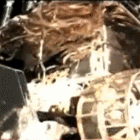 China successfully lands the unmanned lunar lander Chang’e 3 on the surface of the moon, only the third country on Earth to achieve a controlled lunar landing (and the first soft landing of a man-made space vehicle on the moon since the 1970s). With Chang’e 3 confirming that its solar panels have properly deployed, preparations are made to deploy its robotic lunar rover, Yutu, the first lunar rover since 1973, breaking a four-decade drought in exploring the surface of the moon.
China successfully lands the unmanned lunar lander Chang’e 3 on the surface of the moon, only the third country on Earth to achieve a controlled lunar landing (and the first soft landing of a man-made space vehicle on the moon since the 1970s). With Chang’e 3 confirming that its solar panels have properly deployed, preparations are made to deploy its robotic lunar rover, Yutu, the first lunar rover since 1973, breaking a four-decade drought in exploring the surface of the moon. The unmanned Mangalayaan space probe arrives, intact and functioning, in Mars orbit, making India the first country on Earth to successfully reach Mars on its first attempt. (A high failure rate among past Mars missions has plagued both the Russian and American space programs.) A 23-minute engine burn slows Mangalayaan down enough to be captured by Mars’ gravity, but leaves the vehicle with twice the fuel reserves expected for its projected six-month mission.
The unmanned Mangalayaan space probe arrives, intact and functioning, in Mars orbit, making India the first country on Earth to successfully reach Mars on its first attempt. (A high failure rate among past Mars missions has plagued both the Russian and American space programs.) A 23-minute engine burn slows Mangalayaan down enough to be captured by Mars’ gravity, but leaves the vehicle with twice the fuel reserves expected for its projected six-month mission.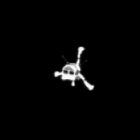 Launched in 2004, the European Space Agency’s Rosetta space probe, orbiting Comet 67P/Churyumov-Gerasimenko in the outer solar system, releases the Philae robotic lander to descend to 67P’s surface. The lander’s harpoon anchoring system doesn’t work entirely as expected, and Philae bounces off the surface and goes spaceborne again for two hours before coming to rest on the comet once more. Though Philae is able to gather scientific data and the first-ever pictures from a comet’s surface, the nearby geography prevents its solar panels from keeping its batteries at a full charge; ESA ground controllers are only able to intermittently contact Philae.
Launched in 2004, the European Space Agency’s Rosetta space probe, orbiting Comet 67P/Churyumov-Gerasimenko in the outer solar system, releases the Philae robotic lander to descend to 67P’s surface. The lander’s harpoon anchoring system doesn’t work entirely as expected, and Philae bounces off the surface and goes spaceborne again for two hours before coming to rest on the comet once more. Though Philae is able to gather scientific data and the first-ever pictures from a comet’s surface, the nearby geography prevents its solar panels from keeping its batteries at a full charge; ESA ground controllers are only able to intermittently contact Philae.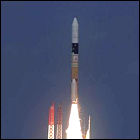 The Japanese Aerospace Exploration Agency (JAXA) launches the Hayabusa-2 unmanned space probe, intended to study and sample asteroid 162173 Ryugu in 2018. Mission plans call for the ion-engine-powered Hayabusa-2 to remain at Ryugu for a year before returning to Earth with its sample. Hayabusa-2 also carries a European-built lander and an explosive penetrator to expose the asteroid’s subsurface material (using the same principle as the Deep Impact mission to Comet Tempel 1 in 2005.
The Japanese Aerospace Exploration Agency (JAXA) launches the Hayabusa-2 unmanned space probe, intended to study and sample asteroid 162173 Ryugu in 2018. Mission plans call for the ion-engine-powered Hayabusa-2 to remain at Ryugu for a year before returning to Earth with its sample. Hayabusa-2 also carries a European-built lander and an explosive penetrator to expose the asteroid’s subsurface material (using the same principle as the Deep Impact mission to Comet Tempel 1 in 2005.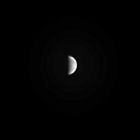 JAXA, the Japanese space agency, announces its plans to put the unmanned AKATSUKI space probe into orbit around Venus. Originally launched in 2010, AKATSUKI failed to orbit the planet in December of that year due to a critical engine malfunction and instead fell into an orbit around the sun, but mission planners have devised a strategy to use its attitude control engines to slow it enough to be captured around Venus when it intersects the planet’s orbit again. AKATSUKI, more formally known as the Venus Climate Orbiter, is intended to study the atmosphere and weather of Venus, a mission it will begin in December if it can successfully enter orbit.
JAXA, the Japanese space agency, announces its plans to put the unmanned AKATSUKI space probe into orbit around Venus. Originally launched in 2010, AKATSUKI failed to orbit the planet in December of that year due to a critical engine malfunction and instead fell into an orbit around the sun, but mission planners have devised a strategy to use its attitude control engines to slow it enough to be captured around Venus when it intersects the planet’s orbit again. AKATSUKI, more formally known as the Venus Climate Orbiter, is intended to study the atmosphere and weather of Venus, a mission it will begin in December if it can successfully enter orbit. IDMusic releases
IDMusic releases 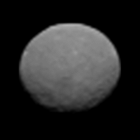 The unmanned NASA spacecraft Dawn transmits a series of pictures of Ceres, the minor planet which is the largest known object in the main asteroid belt between Mars and Jupiter, back to Earth, representing the best view yet of an object which had been seen as little more than a point of light since its discovery in 1801. From a distance of only 147,000 miles, Dawn is able to see more detail on Ceres than the best Hubble Space Telescope images of the same body. Dawn will arrive at Ceres and use its ion propulsion system to enter its orbit in March 2015.
The unmanned NASA spacecraft Dawn transmits a series of pictures of Ceres, the minor planet which is the largest known object in the main asteroid belt between Mars and Jupiter, back to Earth, representing the best view yet of an object which had been seen as little more than a point of light since its discovery in 1801. From a distance of only 147,000 miles, Dawn is able to see more detail on Ceres than the best Hubble Space Telescope images of the same body. Dawn will arrive at Ceres and use its ion propulsion system to enter its orbit in March 2015. Dutton Books publishes
Dutton Books publishes 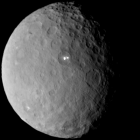 The unmanned NASA/JPL space probe Dawn arrives at its second and final destination, the dwarf planet Ceres, a body which dominates the asteroid belt between Mars and Jupiter. Beginning to bring itself into a closer mapping orbit around Ceres, Dawn has already spotted unusually bright surface features, drawing early speculation from scientists that the highly reflective points on Ceres may be indicative of ice formations or cryovolcanism. Though its main engine is powered by charged ions, Dawn is scheduled to remain at Ceres for as long as its chemical propellant supply holds, powering smaller traditional rockets needed for attitude control.
The unmanned NASA/JPL space probe Dawn arrives at its second and final destination, the dwarf planet Ceres, a body which dominates the asteroid belt between Mars and Jupiter. Beginning to bring itself into a closer mapping orbit around Ceres, Dawn has already spotted unusually bright surface features, drawing early speculation from scientists that the highly reflective points on Ceres may be indicative of ice formations or cryovolcanism. Though its main engine is powered by charged ions, Dawn is scheduled to remain at Ceres for as long as its chemical propellant supply holds, powering smaller traditional rockets needed for attitude control. The second Boeing X-37B unmanned spacecraft, last flown in 2011-2012, returns to orbit atop an Atlas V rocket. Operated by the U.S. Air Force, the X-37B stays in orbit for just a few days shy of two years, performing classified military tasks as well as research for NASA, and it is capable of re-entering the atmosphere and gliding to a runway landing, very much like the Space Shuttle, of which it resembles a smaller version. Also deployed along with the X-37B is LightSail, an experimental solar sail test vehicle designed, built, paid for and operated by the Planetary Society, building on solar sail concepts originated by Society co-founder Carl Sagan. In a first, the mission will end on the former space shuttle landing strip at Kennedy Space Center in 2017.
The second Boeing X-37B unmanned spacecraft, last flown in 2011-2012, returns to orbit atop an Atlas V rocket. Operated by the U.S. Air Force, the X-37B stays in orbit for just a few days shy of two years, performing classified military tasks as well as research for NASA, and it is capable of re-entering the atmosphere and gliding to a runway landing, very much like the Space Shuttle, of which it resembles a smaller version. Also deployed along with the X-37B is LightSail, an experimental solar sail test vehicle designed, built, paid for and operated by the Planetary Society, building on solar sail concepts originated by Society co-founder Carl Sagan. In a first, the mission will end on the former space shuttle landing strip at Kennedy Space Center in 2017.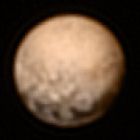 NASA’s New Horizons abruptly loses contact with Earth-based ground controllers and then signals that it has gone into safe mode, ten days before its closest flyby of Pluto. In this mode, the spacecraft gathers no scientific data, and awaits intervention from Earth, but its distance from Earth – four billion miles away – means that signals transmitted to or from New Horizons take four and a half hours to reach their destination (and any reply takes just as long). A timing error is located in New Horizons’ automatic event sequencer, a vital part of its mission since it will need to operate independently to conduct hundreds of observations of Pluto and its satellites with no contact from Earth until later, and the probe is rebooted within 48 hours. Though the probe’s automatic switch to failsafe mode has cost the mission some scientific observations, most of the high-value data will not be collected until within 24 hours of closest approach on July 14th.
NASA’s New Horizons abruptly loses contact with Earth-based ground controllers and then signals that it has gone into safe mode, ten days before its closest flyby of Pluto. In this mode, the spacecraft gathers no scientific data, and awaits intervention from Earth, but its distance from Earth – four billion miles away – means that signals transmitted to or from New Horizons take four and a half hours to reach their destination (and any reply takes just as long). A timing error is located in New Horizons’ automatic event sequencer, a vital part of its mission since it will need to operate independently to conduct hundreds of observations of Pluto and its satellites with no contact from Earth until later, and the probe is rebooted within 48 hours. Though the probe’s automatic switch to failsafe mode has cost the mission some scientific observations, most of the high-value data will not be collected until within 24 hours of closest approach on July 14th. Dr. Claudia Alexander dies at the age of 56, while still serving as the chief scientist of a suite of U.S.-provided instruments aboard ESA’s history-making Rosetta mission. Renowned as one of JPL’s finest research scientists, she was a member of the Galileo plasma instrument science team before becoming, by the mission’s end in 2003, the project manager of that mission to Jupiter.
Dr. Claudia Alexander dies at the age of 56, while still serving as the chief scientist of a suite of U.S.-provided instruments aboard ESA’s history-making Rosetta mission. Renowned as one of JPL’s finest research scientists, she was a member of the Galileo plasma instrument science team before becoming, by the mission’s end in 2003, the project manager of that mission to Jupiter.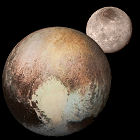 Nine years after its launch from Earth, NASA’s New Horizons space probe passes within 8,000 miles of the surface of Pluto, and within 18,000 miles of Pluto’s largest moon, Charon. Detailed images and observations are obtained of both of these bodies, with less detailed data gathered on Pluto’s four smaller, outermost moons. Cruising through the Pluto system at 30,000 miles per hour, New Horizons must break contact with Earth for nearly a full day to aim its cameras and other instruments at their targets. It’s not until some 12 hours after the point of closest flyby that New Horizons re-establishes contact with Earth, reporting that it has successfully completed the encounter with no problems.
Nine years after its launch from Earth, NASA’s New Horizons space probe passes within 8,000 miles of the surface of Pluto, and within 18,000 miles of Pluto’s largest moon, Charon. Detailed images and observations are obtained of both of these bodies, with less detailed data gathered on Pluto’s four smaller, outermost moons. Cruising through the Pluto system at 30,000 miles per hour, New Horizons must break contact with Earth for nearly a full day to aim its cameras and other instruments at their targets. It’s not until some 12 hours after the point of closest flyby that New Horizons re-establishes contact with Earth, reporting that it has successfully completed the encounter with no problems.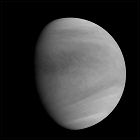 The Japanese space probe AKATSUKI, launched in 2010 but left in an orbit around the sun by an engine glitch, catches up with its original target, the planet Venus, and fires its attitude control thrusters. The lengthy engine burn slows AKATSUKI enough to be captured by Venus’ gravity, in an elliptical 13-day orbit that brings the probe within 250 miles of the Venusian clouds it was sent to study at its closest, and nearly a quarter million miles away from the planet at the furthest. Another engine burn is planned for March 2016 to circularize and shorten AKATSUKI’s orbit so it can begin its observations of the planet’s weather patterns.
The Japanese space probe AKATSUKI, launched in 2010 but left in an orbit around the sun by an engine glitch, catches up with its original target, the planet Venus, and fires its attitude control thrusters. The lengthy engine burn slows AKATSUKI enough to be captured by Venus’ gravity, in an elliptical 13-day orbit that brings the probe within 250 miles of the Venusian clouds it was sent to study at its closest, and nearly a quarter million miles away from the planet at the furthest. Another engine burn is planned for March 2016 to circularize and shorten AKATSUKI’s orbit so it can begin its observations of the planet’s weather patterns.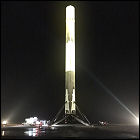 For the first time since a failed Dragon capsule launch to the International Space Station in June, SpaceX launches its Falcon 9 rocket with a payload of 11 OrbComm mini-satellites. After the second stage separates to go on to successfully deploy the OrbComm satellites, the first stage performs three engine burns to return for a stable landing. For the first time (after two previous attempts on oceangoing unmanned barges), the Falcon 9 drops to a gentle landing at a designated landing zone at Cape Canaveral, potentially paving the way for rockets whose first stages can return home for refurbishing and relaunch.
For the first time since a failed Dragon capsule launch to the International Space Station in June, SpaceX launches its Falcon 9 rocket with a payload of 11 OrbComm mini-satellites. After the second stage separates to go on to successfully deploy the OrbComm satellites, the first stage performs three engine burns to return for a stable landing. For the first time (after two previous attempts on oceangoing unmanned barges), the Falcon 9 drops to a gentle landing at a designated landing zone at Cape Canaveral, potentially paving the way for rockets whose first stages can return home for refurbishing and relaunch. JAXA, the Japanese Space Agency, launches the ASTRO-H X-ray observatory satellite, nicknamed Hitomi, from Tanegashima Space Center. Carrying equipment provided by NASA and the Canadian Space Agency, Hitomi is intended to remain operational for three years, conducting X-ray astronomy from low Earth orbit. Though the launch proceeds without apparent problems, major technical issues will prevent Hitomi from fulfilling its mission objectives.
JAXA, the Japanese Space Agency, launches the ASTRO-H X-ray observatory satellite, nicknamed Hitomi, from Tanegashima Space Center. Carrying equipment provided by NASA and the Canadian Space Agency, Hitomi is intended to remain operational for three years, conducting X-ray astronomy from low Earth orbit. Though the launch proceeds without apparent problems, major technical issues will prevent Hitomi from fulfilling its mission objectives.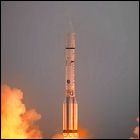 The European Space Agency’s unmanned Mars Trace Gas Orbiter, nicknamed ExoMars, lifts off via a Russian Proton rocket on a course for Mars. Carrying a small lander named Schiaparelli (named after the Italian astronomer who was instrumental in early mapping of Martian surface features via telescope), ExoMars is scheduled to arrive at the red planet in October 2016, deliver the Schiaparelli lander, and then enter orbit to search for traces and origins of methane in the Martian atmosphere, to determine if the presence of that gas – usually associated with biological activity on Earth – is geochemical in nature, or is derived from another source. Plans then call for ExoMars to join the fleet of artificial satellites relaying communications from current and future Mars-exploring rovers and landers to Earth through the 2020s.
The European Space Agency’s unmanned Mars Trace Gas Orbiter, nicknamed ExoMars, lifts off via a Russian Proton rocket on a course for Mars. Carrying a small lander named Schiaparelli (named after the Italian astronomer who was instrumental in early mapping of Martian surface features via telescope), ExoMars is scheduled to arrive at the red planet in October 2016, deliver the Schiaparelli lander, and then enter orbit to search for traces and origins of methane in the Martian atmosphere, to determine if the presence of that gas – usually associated with biological activity on Earth – is geochemical in nature, or is derived from another source. Plans then call for ExoMars to join the fleet of artificial satellites relaying communications from current and future Mars-exploring rovers and landers to Earth through the 2020s.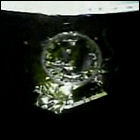 Japan’s Hitomi satellite, launched in February on a three-year X-ray astronomy mission, suddenly breaks contact with JAXA ground controllers when they begin power-up and checkout procedures. Only brief telemetry signals are received from Hitomi before it falls silent. JAXA initiates emergency procedures to contact Hitomi and diagnose the problem, though some telescopic observations from Earth indicate that pieces of the spacecraft have fallen away from the spacecraft itself.
Japan’s Hitomi satellite, launched in February on a three-year X-ray astronomy mission, suddenly breaks contact with JAXA ground controllers when they begin power-up and checkout procedures. Only brief telemetry signals are received from Hitomi before it falls silent. JAXA initiates emergency procedures to contact Hitomi and diagnose the problem, though some telescopic observations from Earth indicate that pieces of the spacecraft have fallen away from the spacecraft itself.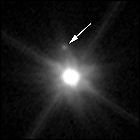 Astronomers reveal that Makemake, an icy dwarf planet orbiting in the distant Kuiper Belt region of the solar system, has a moon, first spotted in 2015 by a team using the Hubble Space Telescope. (The news comes just days after the 26th anniversary of Hubble’s launch.) With an estimated diameter of 100 miles (compared to the 870 mile diameter of its parent body), the satellite orbits Makemake at a distance of 13,000 miles, taking twelve days to complete one orbit. Previous observations failed to pick up on the dark, dim body due to the relatively bright glare of Makemake itself.
Astronomers reveal that Makemake, an icy dwarf planet orbiting in the distant Kuiper Belt region of the solar system, has a moon, first spotted in 2015 by a team using the Hubble Space Telescope. (The news comes just days after the 26th anniversary of Hubble’s launch.) With an estimated diameter of 100 miles (compared to the 870 mile diameter of its parent body), the satellite orbits Makemake at a distance of 13,000 miles, taking twelve days to complete one orbit. Previous observations failed to pick up on the dark, dim body due to the relatively bright glare of Makemake itself.  JAXA, the Japanese Space Agency, declares the Hitomi X-ray astronomy satellite a total loss, having lost all contact with it. Though the diagnosis of the evidence to date is ongoing, engineers conclude from the available data that Hitomi entered an uncontrolled spin and broke up in orbit. JAXA offers apologies not only to other countries’ space agencies who supplied equipment for Hitomi, as well as to astronomers who had hoped to use the satellite.
JAXA, the Japanese Space Agency, declares the Hitomi X-ray astronomy satellite a total loss, having lost all contact with it. Though the diagnosis of the evidence to date is ongoing, engineers conclude from the available data that Hitomi entered an uncontrolled spin and broke up in orbit. JAXA offers apologies not only to other countries’ space agencies who supplied equipment for Hitomi, as well as to astronomers who had hoped to use the satellite. Private space launch contractor SpaceX once again successfully lands the first stage of a Falcon 9 rocket after the booster lifts a Japanese communications satellite into a parking orbit (from which the second stage propels the satellite to geostationary orbit). This second consecutive landing of a Falcon 9 first stage takes place at sea again, with the booster coming in for a faster landing then its
Private space launch contractor SpaceX once again successfully lands the first stage of a Falcon 9 rocket after the booster lifts a Japanese communications satellite into a parking orbit (from which the second stage propels the satellite to geostationary orbit). This second consecutive landing of a Falcon 9 first stage takes place at sea again, with the booster coming in for a faster landing then its  NASA’s Hubble Space Telescope confirms the observations of Earthbound astronomers with high-powered telescopes: a new dark atmospheric feature has emerged on the planet Neptune, signifying a major new storm system in the planet’s atmosphere. The new vortex feature emerges near the south polar area of Neptune, and was first observed by telescope in 2015.
NASA’s Hubble Space Telescope confirms the observations of Earthbound astronomers with high-powered telescopes: a new dark atmospheric feature has emerged on the planet Neptune, signifying a major new storm system in the planet’s atmosphere. The new vortex feature emerges near the south polar area of Neptune, and was first observed by telescope in 2015.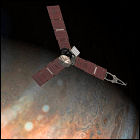 NASA’s Juno space probe successfully pulls of a risky orbital insertion maneuver, slowing itself down just enough to be captured into an unprecedented polar orbit around Jupiter. Launched in 2011, Juno’s first close pass of Jupiter brings it within 3,100 miles of Jupiter’s cloudtops, the closest any spacecraft has ever approached the huge planet. Its polar orbit will allow it to reduces its exposure to Jupiter’s intense magnetic field, which is powerful enough in the planet’s equatorial regions to damage or destroy on-board electronics. Juno’s mission is expected to last 20 months.
NASA’s Juno space probe successfully pulls of a risky orbital insertion maneuver, slowing itself down just enough to be captured into an unprecedented polar orbit around Jupiter. Launched in 2011, Juno’s first close pass of Jupiter brings it within 3,100 miles of Jupiter’s cloudtops, the closest any spacecraft has ever approached the huge planet. Its polar orbit will allow it to reduces its exposure to Jupiter’s intense magnetic field, which is powerful enough in the planet’s equatorial regions to damage or destroy on-board electronics. Juno’s mission is expected to last 20 months. NASA’s Juno spacecraft completes its first orbit of giant planet Jupiter with an orbit-shaping manever that takes it as close to Jupiter’s cloudtops as 2,600 miles – less than the width of the continental United States – at a speed of over 100,000 miles per hour. Juno obtains the first close-up views of the north and south poles of the planet, revealing a roiling hotbed of storm activity unlike the poles of relatively quiet Saturn. In addition to photos, Juno scans the planet in the infrared and ultraviolet portions of the spectrum. This is scheduled to be Juno’s closest flyby of its entire mission.
NASA’s Juno spacecraft completes its first orbit of giant planet Jupiter with an orbit-shaping manever that takes it as close to Jupiter’s cloudtops as 2,600 miles – less than the width of the continental United States – at a speed of over 100,000 miles per hour. Juno obtains the first close-up views of the north and south poles of the planet, revealing a roiling hotbed of storm activity unlike the poles of relatively quiet Saturn. In addition to photos, Juno scans the planet in the infrared and ultraviolet portions of the spectrum. This is scheduled to be Juno’s closest flyby of its entire mission.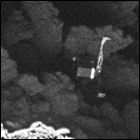 With mere weeks left before the European Space Agency’s Rosetta space probe is shut down, the spacecraft’s gradually decreasing orbit allows it to see more fine detail on the surface of Comet 67P/Churyumov–Gerasimenko, which is now outbound near the orbit of Jupiter. Rosetta’s surface survey finally reveals the fate of the short-lived Philae lander: as ESA engineers suspected in 2014, it came to rest on its side in a crevasse, preventing its batteries from recharging via its solar panels. Originally aimed at the Agilkia region on the larger of Comet 67P’s two “lobes”, Philae’s harpoon anchoring system failed to fire, leaving the lander to bounce helplessly into a ravine on the smaller lobe of the comet, in the Abydos region. It only relayed its surface findings to Rosetta for three days in late 2014. Rosetta would soon join Philae on the surface, with a surface impact scheduled for September 30, 2016.
With mere weeks left before the European Space Agency’s Rosetta space probe is shut down, the spacecraft’s gradually decreasing orbit allows it to see more fine detail on the surface of Comet 67P/Churyumov–Gerasimenko, which is now outbound near the orbit of Jupiter. Rosetta’s surface survey finally reveals the fate of the short-lived Philae lander: as ESA engineers suspected in 2014, it came to rest on its side in a crevasse, preventing its batteries from recharging via its solar panels. Originally aimed at the Agilkia region on the larger of Comet 67P’s two “lobes”, Philae’s harpoon anchoring system failed to fire, leaving the lander to bounce helplessly into a ravine on the smaller lobe of the comet, in the Abydos region. It only relayed its surface findings to Rosetta for three days in late 2014. Rosetta would soon join Philae on the surface, with a surface impact scheduled for September 30, 2016.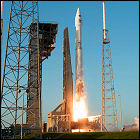 NASA launches the unmanned OSIRIS-REx (Origins Spectral Interpretation Resource Identification Security Regolith Explorer) spacecraft, bound for the asteroid Bennu, a target it won’t reach for two years. Once at Bennu, OSIRIS-REx is intended to orbit the asteroid and then drop down close enough to gather surface samples for return to Earth in a small sample container capable of surviving re-entry through the atmosphere. The samples from Bennu, an asteroid considered a hazard for Earth in the future, will not arrive until September 2023.
NASA launches the unmanned OSIRIS-REx (Origins Spectral Interpretation Resource Identification Security Regolith Explorer) spacecraft, bound for the asteroid Bennu, a target it won’t reach for two years. Once at Bennu, OSIRIS-REx is intended to orbit the asteroid and then drop down close enough to gather surface samples for return to Earth in a small sample container capable of surviving re-entry through the atmosphere. The samples from Bennu, an asteroid considered a hazard for Earth in the future, will not arrive until September 2023.